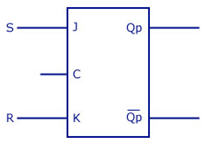

The Master-Slave Flip-Flop is basically two gated SR flip-flops connected together in a series configuration with the slave having an inverted clock pulse. Other Popular JK Flip-flop ICs Device Numberĭual JK-type Flip Flops with Preset and Clear Other such IC’s include the 74LS107 Dual JK flip-flop with clear, the 74LS109 Dual positive-edge triggered JK flip flop and the 74LS112 Dual negative-edge triggered flip-flop with both preset and clear inputs. The TTL 74LS73 is a Dual JK flip-flop IC, which contains two individual JK type bistable’s within a single chip enabling single or master-slave toggle flip-flops to be made. This results in the two sections, the master section and the slave section being enabled during opposite half-cycles of the clock signal. One flip-flop acts as the “Master” circuit, which triggers on the leading edge of the clock pulse while the other acts as the “Slave” circuit, which triggers on the falling edge of the clock pulse. The master-slave flip-flop eliminates all the timing problems by using two SR flip-flops connected together in a series configuration. As this is sometimes not possible with basic JK’s built using basic NAND or NOR gates, far more advanced master-slave (edge-triggered) flip-flops were developed which are more stable. To avoid this the timing pulse period ( T ) must be kept as short as possible (high frequency). While this JK flip-flop circuit is an improvement on the clocked SR flip-flop it also suffers from timing problems called “race” if the output Q changes state before the timing pulse of the clock input has time to go “OFF”. However, as the outputs are fed back to the inputs, this can cause the output at Q to oscillate between SET and RESET continuously after being complemented once. This results in the JK flip-flop acting more like a T-type toggle flip-flop when both terminals are “HIGH”. However, if both the J and K inputs are HIGH at logic “1” (J = K = 1), when the clock input goes HIGH, the circuit will “toggle” as its outputs switch and change state complementing each other. Then the JK flip-flop is basically an SR flip flop with feedback which enables only one of its two input terminals, either SET or RESET to be active at any one time under normal switching thereby eliminating the invalid condition seen previously in the SR flip flop circuit. The Truth Table for the JK Function same as When both inputs J and K are equal to logic “1”, the JK flip flop toggles as shown in the following truth table. As Q and Q are always different we can use them to control the input. If the circuit is “RESET” the K input is inhibited by the “0” status of Q through the upper NAND gate. If the circuit is now “SET” the J input is inhibited by the “0” status of Q through the lower NAND gate.

The difference this time is that the “JK flip flop” has no invalid or forbidden input states of the SR Latch even when S and R are both at logic “1”. The sequential operation of the JK flip flop is exactly the same as for the previous SR flip-flop with the same “Set” and “Reset” inputs. The two inputs labelled “J” and “K” are not shortened abbreviated letters of other words, such as “S” for Set and “R” for Reset, but are themselves autonomous letters chosen by its inventor Jack Kilby to distinguish the flip-flop design from other types. This simple JK flip Flop is the most widely used of all the flip-flop designs and is considered to be a universal flip-flop circuit. Then to overcome these two fundamental design problems with the SR flip-flop design, the JK flip Flop was developed. if Set or Reset change state while the enable (EN) input is high the correct latching action may not occur the Set = 0 and Reset = 0 condition (S = R = 0) must always be avoided Unlike the JK Flip-flop, the basic S-R NAND flip-flop circuit has many advantages and uses in sequential logic circuits but it suffers from two basic switching problems.


 0 kommentar(er)
0 kommentar(er)
